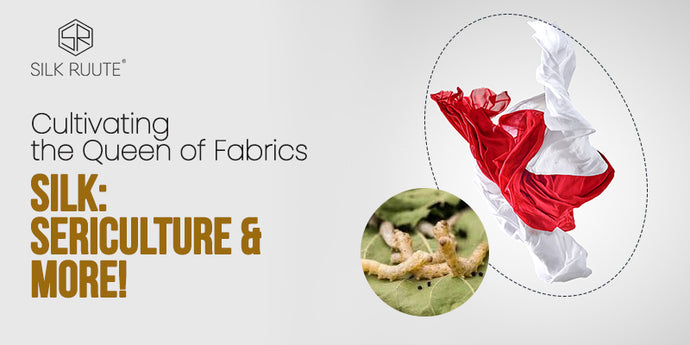
Cultivating the Queen of Fabrics – Silk: Sericulture & More!
Silk is an incredibly beautiful and high-in-demand fabric. Its beauty and elegance are why it has always been revered as royal and labelled as the queen of fabrics. But do you know how silk is actually prepared? While most of you may have heard that it is produced from silkworms, only a few of you might know the process behind silk production.
After all, producing silk from silkworms is not just a one-step process. It’s an extensive and mind-blowing procedure that you might not have ever heard about. If you wish to know all about Sericulture and learn more about silk production, this blog is curated just for you. So, the next time when you buy silk blend scarves, you might know how that silk was procured.
Without wasting any more time, let us begin!
What exactly is Sericulture?
The process of silk production from silkworms is known as Sericulture. It is an agro-based industry that involves the rearing of silkworms so that raw silk can be produced from cocoons of certain insect species such as spiders and mussels but most prominently silkworms. The main activities in Sericulture are cultivation to provide food for the silkworms that spin silk cocoons and reeling the cocoons to unravel the silk filament for manufacturing and weaving. Reapers need to ensure that the silkworms get appropriate food during the stage of their larval growth so that they properly transform.

During Sericulture, the silkworms go through varying stages:
Stage 1- The Egg
Production of any beautiful silk outfit, you might have, begins from the eggs of a grown silkmoth. You would be surprised to know that a female silkmoth can lay up to 500 eggs. Within a few days, the eggs, originally yellow in colour, turn dark brown, which are then incubated at a certain temperature and left for hatching into larvae for 10-12 days.
Stage 2: The Larval Stage
Once hatched, these larvae are transferred from the incubation unit to the rearing room, where they are fed a sumptuous diet of mulberry leaves. The larval stage is also the longest phase in a silkmoth’s lifecycle.
Stage 3: The Pupa
The feast is over now! Now comes the time for the caterpillars to start spinning their cocoons so that they pupate and transform into moths. This stage involves mounting, where the mature silkworms are hand-transferred to mountages. In the mountages, larvae start to spin silk around them.
After about a week from the time the cocoon is spun, they are steamed or boiled. The cocoons at this stage of the silk production process are prepared to be processed into raw silk.
How is Silk Prepared?
The process of making silk involves the following:
- Harvesting
- Stifling and Sorting
- Boiling the cocoons
- De-flossing to break loose fibre
- Reeling to turn cocoons into silk threads
- Twisting and Dying
- Weaving thread into the fabric
We hope this blog has helped you understand how silk is obtained from a silkmoth. Silk fabric and silk production is an ancient process that we must safeguard. Silk Ruute is one such brand that is proud to have taken forward the legacy of Bhagalpuri silk. Our store has an elegant collection of silk scarves and stoles that can enhance the beauty of any outfit. Now you can buy silk stoles online in India with our online store. Check out our collection right away!
